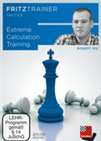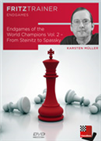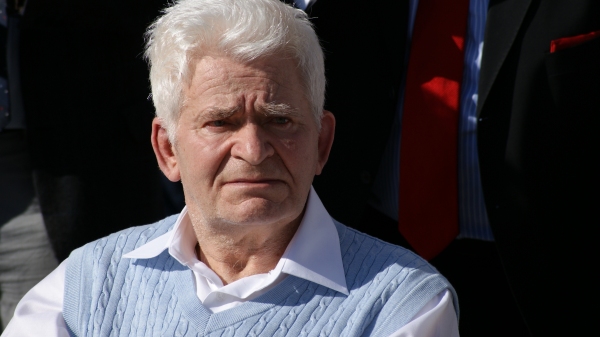Looking back on his 200th anniversary
There was a time when the King's Gambit was a popular opening at top tournaments. With 1.e4 e5 2.f4!? White indicates that he is ready to give material to open lines to mate the enemy king.
Perhaps the Austrian Master Ernst Falkbeer thought that it's best to fight fire with fire when he was playing a match against Adolf Anderssen in 1851 and decided to counter Anderssen's King's Gambit with 1.e4 e5 2.f4 d5 3.exd5 e4!?
With 3...e4 Black sacrifices a pawn to seize the initiative, and indicates that he is ready to give material to open lines to mate the enemy king. When Falkbeer first tried this idea against Anderssen in 1851 he did not have much success but Falkbeer's idea later still found a lot of followers.
| Replay and check the LiveBook here |
Please, wait...
1.e4 e5 2.f4 d5 3.exd5 e4 4.Bb5+ Bd7 5.Qe2 Nf6 6.Nc3 Bc5 7.Nxe4 0-0 8.Bxd7 Nbxd7 9.d3 Nxd5 10.Nf3 Re8 11.f5 Bb4+ 12.Kf2 N7f6 13.g3 Qd7 14.c4 Nxe4+ 15.dxe4 Nf6 16.e5 Qxf5 17.Kg2 Rad8 18.a3 Bd6 19.Rd1 Qh5 20.c5 Rxe5 21.Qxe5 Qg4 22.cxd6 Re8 23.Qxe8+ Nxe8 24.d7 Qe4 25.d8Q Qc2+ 26.Bd2 1–0
- Start an analysis engine:
- Try maximizing the board:
- Use the four cursor keys to replay the game. Make moves to analyse yourself.
- Press Ctrl-B to rotate the board.
- Drag the split bars between window panes.
- Download&Clip PGN/GIF/FEN/QR Codes. Share the game.
- Games viewed here will automatically be stored in your cloud clipboard (if you are logged in). Use the cloud clipboard also in ChessBase.
- Create an account to access the games cloud.
| Anderssen,A | - | Falkbeer,E | - | 1–0 | 1851 | C32 | Berlin m3 | |
Please, wait...
This DVD concentrates on the King's Gambit accepted with 3.Bc4. Williams has included a lot of novelties and interesting attacking variations that should wet the lips of any attacking player, looking for an interesting way of meeting 1...e5!
Anderssen himself and other top players of his time such as Paul Morphy, Howard Staunton, Louis Paulsen, Gustav Neumann or Berthold Suhle picked up Falkbeer's idea and scored fine victories with it.
For instance, in 1862 Anderssen won a nice game against Rosanes in Breslau, and in 1858 Paul Morphy won an entertaining casual game against Schulten.
| Replay and check the LiveBook here |
Please, wait...
1.e4 e5 2.f4 d5 3.exd5 e4 4.Bb5+ c6 5.dxc6 Nxc6 6.Nc3 Nf6 7.Qe2 Bc5 8.Nxe4 0-0 9.Bxc6 bxc6 10.d3 Re8 11.Bd2 Nxe4 12.dxe4 Bf5 13.e5 Qb6 14.0-0-0 Bd4 15.c3 Rab8 16.b3 Red8 17.Nf3 Qxb3! 18.axb3 Rxb3 19.Be1 Be3+! 0–1
- Start an analysis engine:
- Try maximizing the board:
- Use the four cursor keys to replay the game. Make moves to analyse yourself.
- Press Ctrl-B to rotate the board.
- Drag the split bars between window panes.
- Download&Clip PGN/GIF/FEN/QR Codes. Share the game.
- Games viewed here will automatically be stored in your cloud clipboard (if you are logged in). Use the cloud clipboard also in ChessBase.
- Create an account to access the games cloud.
| Rosanes,J | - | Anderssen,A | - | 0–1 | 1862 | C32 | Breslau | |
Please, wait...

Adolf Anderssen | Photo: German Chess Federation
| Replay and check the LiveBook here |
Please, wait...
1.e4 e5 2.f4 d5 3.exd5 e4 4.Nc3 Nf6 5.d3 Bb4 6.Bd2 e3 7.Bxe3 0-0 8.Bd2 Bxc3 9.bxc3 Re8+ 10.Be2 Bg4 11.c4 11.Kf1 11...c6 12.dxc6? 12.h3 12...Nxc6 13.Kf1 Rxe2-+ 14.Nxe2 Nd4 15.Qb1 Bxe2+ 16.Kf2 Ng4+ 17.Kg1 Nf3+ 18.gxf3 Qd4+ 19.Kg2 Qf2+ 20.Kh3 Qxf3+ 0–1
- Start an analysis engine:
- Try maximizing the board:
- Use the four cursor keys to replay the game. Make moves to analyse yourself.
- Press Ctrl-B to rotate the board.
- Drag the split bars between window panes.
- Download&Clip PGN/GIF/FEN/QR Codes. Share the game.
- Games viewed here will automatically be stored in your cloud clipboard (if you are logged in). Use the cloud clipboard also in ChessBase.
- Create an account to access the games cloud.
| Schulten,J | - | Morphy,P | - | 0–1 | 1858 | C32 | USA-01 Casuals Morphy-Schulten +28-1=0 | |
Please, wait...
Later players such as Zukertort, Pillsbury, Lasker, Marshall, Nimzowitsch, Tarrasch or Alekhine occasionally tried Falkbeer's Countergambit just as Keres, Bronstein, Tal or Unzicker. Keres was particularly fond of this line and played it with White and with Black. His game against Vladimir Petrovs at the final of the Soviet Championship 1940 shows how White can strive for tactics and an attack against Black's countergambit.
| Replay and check the LiveBook here |
Please, wait...
1.e4 e5 2.f4 d5 3.exd5 e4 4.d3 Nf6 5.Nd2 exd3 6.Bxd3 Qxd5 7.Ngf3 Bc5 8.Qe2+ Qe6 9.Ne5 0-0 10.Ne4 Nxe4 11.Qxe4 g6 12.b4 Be7 13.Bb2 Bf6 14.0-0-0 Nc6 15.h4 h5 16.g4 Bxe5 17.fxe5 Qxg4 18.Qe3 Nxb4 19.e6 Nd5 20.exf7+ Rxf7 21.Bc4 c6 22.Rxd5 Qxc4 23.Qe8+ 1–0
- Start an analysis engine:
- Try maximizing the board:
- Use the four cursor keys to replay the game. Make moves to analyse yourself.
- Press Ctrl-B to rotate the board.
- Drag the split bars between window panes.
- Download&Clip PGN/GIF/FEN/QR Codes. Share the game.
- Games viewed here will automatically be stored in your cloud clipboard (if you are logged in). Use the cloud clipboard also in ChessBase.
- Create an account to access the games cloud.
| Keres,P | - | Petrovs,V | - | 1–0 | 1940 | C32 | URS-ch12 Final | 19 |
Please, wait...
 Special attention will be paid to Intermediate Moves, Quiet Moves, Sacrifices on Empty Squares, Mating Patterns, Ignoring Opponents Threat, Calculation in Defence and Method of Comparison. Plus 50 interactive examples to test your knowledge.
Special attention will be paid to Intermediate Moves, Quiet Moves, Sacrifices on Empty Squares, Mating Patterns, Ignoring Opponents Threat, Calculation in Defence and Method of Comparison. Plus 50 interactive examples to test your knowledge.
Paul Keres 1936 | Source unknown
Boris Spassky also enjoyed the tactical potential of this line:
| Replay and check the LiveBook here |
Please, wait...
1.e4 e5 2.f4 d5 3.exd5 e4 4.Nc3 Nf6 5.Bc4 Bc5 6.Nge2 0-0 7.d4 exd3 8.Qxd3 Re8 9.h3 a6 10.a4 Qe7 11.Bd2 c6 12.dxc6 Nxc6 13.0-0-0 Nb4 14.Qf3 b5 15.Qxa8 bxc4 16.Qf3 Bf5 17.Rhe1 Qd7 18.Ng3 Bxc2 19.Rxe8+ Nxe8 20.Nce4 Qxa4 21.Bxb4 Bxb4 22.Rd8 Bd3 23.Rxd3 cxd3 24.Qxd3 Qc6+ 25.Kb1 g6 26.Qd8 Kf8 27.Qd4 Bd6 28.Qh8+ Ke7 29.Qxh7 Bxf4 30.Qh4+ g5 31.Nxg5 Qc1+ 32.Ka2 Bxg5 33.Qb4+ Kd7 34.Qa4+ Qc6 35.Qg4+ Qe6+ 0–1
- Start an analysis engine:
- Try maximizing the board:
- Use the four cursor keys to replay the game. Make moves to analyse yourself.
- Press Ctrl-B to rotate the board.
- Drag the split bars between window panes.
- Download&Clip PGN/GIF/FEN/QR Codes. Share the game.
- Games viewed here will automatically be stored in your cloud clipboard (if you are logged in). Use the cloud clipboard also in ChessBase.
- Create an account to access the games cloud.
| Chepukaitis,G | - | Spassky,B | - | 0–1 | 1952 | C32 | URS U20 Team-ch | |
Please, wait...
 Enjoy Capablanca's fine technique, Tal's magic, Lasker's fighting spirit, Petrosian's defensive skills, Smyslov's feeling for harmony, and Alekhine's and Spassky's flair for the attack.
Enjoy Capablanca's fine technique, Tal's magic, Lasker's fighting spirit, Petrosian's defensive skills, Smyslov's feeling for harmony, and Alekhine's and Spassky's flair for the attack.
Boris Spassky at the age of 80 | Photo: Dagobert Kohlmeyer
Today, the King's Gambit is a rare guest in top tournaments, and Falkbeer's Countergambit is played even less. It is considered to be dubious and Black has other ways to counter the King's Gambit.
However, today is the 200th birthday of Ernst Falkbeer, the initiator of the idea that led to all these entertaining games.
Ernst Karl Falkbeer (June 27, 1819 - December 14, 1885)
Ernst Karl Falkbeer was born in Brünn but later moved to Vienna to study law. But he did not finish his studies and became a journalist instead. However, the authorities did not like Falkbeer's writings and in 1848 he fled Vienna and went to Germany.
In 1853, Falkbeer returned to Vienna where he founded the Wiener Schachzeitung, one of the first chess magazines in the world. But the magazine did not sell well and after a few issues ceased to exist. Falkbeer now went to England where he was in charge of the chess column of the Sunday Times and worked as an editor at the Chessplayers‘ Magazine. In 1872, he returned to Vienna where he lived until his death on December 14th, 1885.
According to the historical ratings calculated by Jeff Sonas between 1855 and 1858 Falkbeer more than once belonged to the world's top five players.
Links
.jpeg)

























